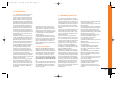
7
5. Internal Adjustments
5.1 Speaker-Level Input
Impedance Adjustments
The speaker level inputs of the GTQ
amplifiers come factory-set with
100k ohm input impedance. This will pro-
vide the lowest distortion operation from
the speaker outputs of most modern head
units by reducing the power the amplifier
in the head unit must deliver to practi-
cally, nothing. On some older or lower-
priced head units this load will not facili-
tate proper fader operation. To allow for
this, we have provided the ability to
change the input impedance of the speak-
er-level inputs to 15 ohms. This is accom-
plished by moving the jumpers shown on
the diagram below. This input is also
capable of directly accepting signals,
when in the 100k ohm setting, from many
Balanced Line Drivers such as those
sometimes used in competition vehicles.
If the head unit has 4 channels of built-in
amplification and/or an electronic fader
control, you should leave the jumpers in
the factory-set position.
If the head unit has 2 channels of amplifi-
cation, with a speaker-level fader, the
jumpers should be set to the 15-ohm
position. This will always be a rotary-type
control, not one controlled by electronic
pushbuttons.
15Ω
100K
REM
OUT
30
30
GND
BAT
LINE INPUT
JUMPER SELECTOR
SELECT 100K OR 15 OHMS
5.2 Crossover Frequency
Adjustments
The GTQ amplifiers include built-in
frequency selectable crossovers. One
crossover is connected in series with the
amplifier circuitry and the other cross-
over is connected to the preamp level out-
put jacks. These crossovers can be set in
either the “F” (full bandwidth operation),
“L” (subwoofer operation), or “H” (satel-
lite operation).
The crossover frequencies are set by
chips inside the amplifier. These chips are
simply a set of resistors, connected
across the pins and molded into a single
package. The crossover frequencies may
be changed to any value desired by
changing the resistor network. JBL has
chips available in the popular values list-
ed in the table which follows. If none of
these suit your system, you may purchase
compatible resistor networks from a local
electronics store, or you may build your
own custom values from discrete resis-
tors mounted on a 14-pin DIP Header
using the instructions which follow.
Frequency Resistor JBL Part
Value Number
50Hz 47k Ω 1-23-750
80Hz 33k Ω 1-23-817
120Hz 22k Ω 1-23-820
200Hz 12k Ω 1-23-821
250Hz 10k Ω 1-23-810
375Hz 6.8k Ω 1-23-822
500Hz 4.7k Ω 1-23-815
650Hz 3.9k Ω 1-23-823
2.5kHz 1k Ω 1-23-824
5kHz 470 Ω 1-23-816
5.3 Custom Chip Construction
Regardless of whether you build or buy it,
the necessary resistor network has the
following configuration:
• Each resistor in the package has the
same value.
• If you know the crossover frequency you
want, you can calculate the resistor value
necessary by solving the following equa-
tion:
Resistor
Value =
in ohms
• Use the following equation if you have a
resistor pack of a known value, and want
to find its crossover frequency:
Frequency
=
in Hz
• To build chips from discrete resistors,
solder the resistors to a standard 14-pin
“DIP Header” according to the diagram. If
a DIP Header is not available, you may
bend the leads of 1⁄4-watt resistors 90
degrees, trim them to 3mm-length, and
insert them directly into the chip sockets.
4.4 Mute Connection
The GTQ amplifier includes a mute input
terminal. This amplifier will mute when a
5V to 12V DC signal is applied to the
“mute” input and will be in normal oper-
ation mode with either a ground or noth-
ing connected to the “mute” input. This
“mute” input is compatible with any
aftermarket noise gate that puts out a
control voltage of
+5V to +12V DC.
4.5 Speaker-Level Input
Harness
Color Codes
Group 1 Left (+): White
Group 1 Left (–): White with
Black Stripe
Group 1 Right (
+): Gray
Group 1 Right (–): Gray with
Black Stripe
Group 2 Left (
+): Green
Group 2 Left (–): Green with
Black Stripe
Group 2 Right (
+): Purple
Group 2 Right (–): Purple with
Black Stripe
2,500,000
Frequency in Hz
2,500,000
Resistor Value in ohms
GTQ 360 new 7/17/98 10:44 AM Page 7














